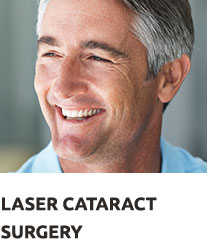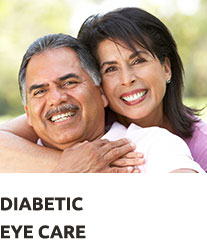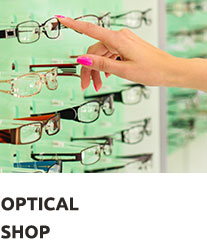Conditions We Treat
Age-Related Macular Degeneration
Age-related macular degeneration (AMD) is the most common cause of vision loss in individuals over the age of 50. The name of the condition derives from its cause: damage to the macula, the most sensitive spot on the retina, required for clarity in the center of the visual field. The macula transmits electrical signals through the optic nerve to the brain. Damage to the macula results in retinal tissue degeneration that gradually worsens, diminishing or destroying central vision.
The speed at which AMD advances is variable. In some patients, the condition progresses slowly and the changes in vision are imperceptible for some time. In others, the disease moves at an accelerated pace, leading relatively quickly to loss of central vision in one or both eyes. While AMD does not result in complete blindness because some peripheral vision always remains, it does make ordinary activities, particularly those that require close visual acuity, increasingly difficult.
Treatment of AMD
While there is not yet a cure for AMD, many patients have been helped greatly by recent innovations in treatment. Regular eye examinations to facilitate early detection of AMD are essential, since most therapies work best when started at an early stage of either type of the disorder. Even though treatments cannot reverse the disease process, they are often able to stop the progression of symptoms so the patient can maintain as much vision as possible.
Recommended treatments for AMD may include one or more of the following, each of which approaches controlling AMD in a somewhat different way:
- Vitamin and mineral supplementation known as AREDS
- Injections of anti-VEGF (vascular endothelial growth factor)
- Laser therapy
- Laser submacular surgery
- Use of low vision aids
An innovative device, known as an implantable miniature telescope (IMT) has been designed to be implanted in place of the patient’s natural lens. While not a cure for AMD, it offers hope for much improved vision for those with the disorder.
Astigmatism
Astigmatism is an eye condition that affects a high percentage of the population. It results from an imperfect curvature of eye that causes refractive error. This means that, when light enters the eye, it is not focused evenly onto the retina. Instead, it is focused either in front of or behind the retina, often resulting in blurred vision.
There are two types of astigmatism: corneal, in which the shape of the cornea is irregular, and lenticular, in which the lens is imperfectly shaped. Corneal astigmatism is more common. Either type of astigmatism can occur in combination with nearsightedness or farsightedness. Astigmatism is frequently so mild that it does not require correction. When it does, there are several treatment options available.
Treatment of Astigmatism
Fortunately, there are several options available to treat astigmatism. The type of treatment chosen depends on the patient’s particular situation and, in some cases, personal preference. Treatments for astigmatism include both nonsurgical and surgical options.
Nonsurgical Treatments
Nonsurgical treatments for astigmatism include corrective lenses of several types: eyeglasses, hard contact lenses and soft contact lenses. Which type of lens is appropriate is decided on an individual basis.
Surgical Treatments
There are also many refractive surgical treatments for astigmatism. These include, but are not limited to the following:
- Limbal relaxing incision (LRI) surgery
- LASIK surgery
- Astigmatic keratotomy surgery (AK)
- Astigmatic-correcting cataract surgery
Candidates for refractive surgery generally have to be free from corneal scars or eye disease.
Whereas contact lenses reshape the eye only while being worn (orthokeratectomy), refractive surgery corrects astigmatism by permanently reshaping the surface of the eye. While still considered safe and effective, keratotomy surgery has recently been largely replaced by LASIK surgery.
Patients with severe astigmatism may still need to wear eyeglasses or contact lenses after astigmatic keratotomy surgery.
Dry Eye
Dry eye is a common condition in which the eyes are insufficiently lubricated, leading to itching, redness and pain. The eyes can become dry and irritated because the tear ducts are not producing a sufficient number of tears, or because there is a chemical imbalance in the tears themselves. Natural tears require a particular chemical balance to lubricate the eyes efficiently.
Alleviating the symptoms of dry eye is important. Left untreated, they have the potential to damage vision. Dry eye can be diagnosed after a thorough examination of the eyes, and a Schirmer tear test to evaluate tear production.
Treatment of Dry Eye
Treatment for dry eye depends on its cause and severity, as well as the patient’s overall health and personal preference.
Nonsurgical Treatments
Nonsurgical treatments, which include the following, are often effective:
- Deliberately blinking
- Increasing humidity levels at home or work
- Using artificial tears or a lubricating ointment
- Avoiding environmental irritants
- Eliminating medications that may be responsible
- Adding Omega-3 fatty acids to the diet or taking them as supplements
In many cases, simple lifestyle changes can alleviate dry-eye symptoms.
Surgical Treatments
If less invasive methods are unsuccessful, surgical treatments, which include the following, may be an option:
- Insertion of punctal plugs to limit tear drainage
- Punctal cautery to permanently close the drainage holes
- Treatment of an underlying disease
If an eyelid condition is causing dry eye, eyelid surgery may be recommended.
If dry eye is left untreated, it can lead to complications that include pain, corneal ulcers/scars or vision loss.
Amblyopia
Amblyopia, also known as lazy eye, is an eye condition that results in reduced vision in one eye. Amblyopia usually affects one eye but has been known to affect both eyes. Amblyopia is the leading cause of visual impairment among children. If left untreated, amblyopia can result in the permanent loss of vision in the affected eye. This condition affects two to three percent of the population as a result of genetic causes, related conditions or trauma. Treatment of amblyopia in children has begun as early as one week old.
Treatment of Amblyopia
Treatment of amblyopia is focused on using only the affected eye so that it could be strengthened. Strengthening of the affected eye can be accomplished by some of the following methods:
- Patching the good eye which forces the lazy eye to strengthen
- Eye drops in the stronger eye that cause it to lose focus
- Corrective lenses
- Ocular exercises
If the case of amblyopia is severe and other methods of treatment have been unsuccessful, cataract surgery or strabismus surgery may be necessary.
Blepharitis
Blepharitis is the chronic inflammation, or infection, of the eyelids and the eyelash follicles along the edge of the eyelid. Blepharitis, which is not contagious, affects patients of all ages.
Treatment of Blepharitis
There is no cure for blepharitis. There is a tendency for the condition to recur making it difficult to treat. It can be controlled with proper hygiene of the eyelids. Treatment and preventative care for blepharitis involves a thorough but gentle cleaning of the eyelids, face and scalp. Warm compresses can be applied to loosen crust and a gentle baby shampoo can help keep the eyelids clean. This treatment may be combined with antibiotics if a bacterial infection is determined to be the cause of the condition.
Cataracts
Each year, cataracts affect millions of people, including more than half of all Americans aged 60 and older. A cataract is a painless clouding of the eye’s natural lens that is caused by a buildup of protein. A cataract can form in one or both eyes. If left untreated, cataracts worsen over time and interfere with everyday activities such as reading or driving. Night vision is usually most affected. When cataracts are in their early stages, people are helped by brighter lighting. As cataracts get worse, however, most people require surgery.
Treatment of Cataracts
Early cataracts can sometimes be treated with nonsurgical methods, including the following:
- New corrective-lens prescriptions
- Anti-glare sunglasses
- Magnifying lenses
- Brighter lighting
If cataracts begin to interfere with reading ability, work, night driving or other daily activities, cataract surgery may be recommended. If cataracts are in both eyes, surgery is performed, usually 4 to 8 weeks apart, on one eye at a time. Cataract surgery is the most common surgical procedure in the United States.









